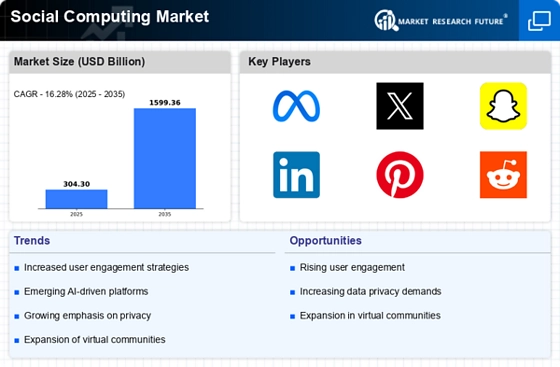The Social Computing Market is currently characterized by a dynamic competitive landscape, driven by rapid technological advancements and evolving consumer preferences. Major players such as Meta Platforms (US), TikTok (CN), and LinkedIn (US) are at the forefront, each adopting distinct strategies to enhance their market positioning. Meta Platforms (US) continues to innovate with its focus on virtual and augmented reality, aiming to create immersive social experiences. Meanwhile, TikTok (CN) leverages its algorithm-driven content delivery to maintain user engagement, while LinkedIn (US) emphasizes professional networking and skill development, thereby catering to a niche yet growing audience. Collectively, these strategies contribute to a competitive environment that is increasingly focused on user experience and engagement, suggesting a shift towards more personalized social computing solutions.
In terms of business tactics, companies are increasingly localizing their operations to better serve regional markets, optimizing supply chains to enhance efficiency. The Social Computing Market appears moderately fragmented, with a mix of established giants and emerging players. This fragmentation allows for diverse offerings, yet the influence of key players remains substantial, as they set trends that smaller companies often follow. The competitive structure is thus shaped by both innovation from leading firms and the agility of smaller entrants, creating a vibrant ecosystem.
In August 2025, Meta Platforms (US) announced the launch of its new Horizon Workrooms, a virtual reality workspace designed to facilitate remote collaboration. This strategic move underscores Meta's commitment to integrating virtual reality into everyday social interactions, potentially redefining how users engage in professional settings. The introduction of such innovative tools may enhance user retention and attract new users seeking advanced collaborative solutions.
In September 2025, TikTok (CN) unveiled a new feature aimed at enhancing user privacy and content control, allowing users to manage their data more effectively. This initiative reflects TikTok's responsiveness to growing concerns over data security, positioning the platform as a leader in user-centric policies. By prioritizing privacy, TikTok not only strengthens its brand reputation but also aligns itself with regulatory trends that are increasingly shaping the digital landscape.
In July 2025, LinkedIn (US) expanded its partnership with various educational institutions to offer more skill-based learning opportunities directly through its platform. This strategic alliance aims to bridge the gap between education and employment, enhancing LinkedIn's value proposition for users seeking career advancement. By fostering such partnerships, LinkedIn reinforces its position as a critical resource for professional development, which may lead to increased user engagement and platform loyalty.
As of October 2025, the Social Computing Market is witnessing trends that emphasize digitalization, sustainability, and the integration of artificial intelligence. Strategic alliances are becoming increasingly pivotal, as companies collaborate to enhance their technological capabilities and market reach. The competitive differentiation is likely to evolve, moving away from traditional price-based competition towards a focus on innovation, technological advancement, and supply chain reliability. This shift suggests that companies that prioritize these aspects will be better positioned to thrive in an ever-evolving market.

















Leave a Comment